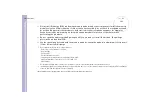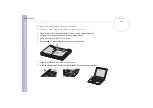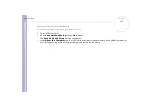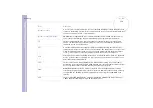
Sony Notebook
User Guide
Glossary
117
L2 cache memory
Cache memory is RAM-like memory that enables quick access to data that has already been
read by the computer. L1 and L2 are levels of cache memory in a computer.
LAN
A LAN (Local Area Network) is a group of computers connected together within a limited
geographical area. It enables users to share devices (such as printers) and information using
one processor or server.
LCD
Short for Liquid Crystal Display. Flat notebook display technology using liquid crystals (and
light polarisation) to provide sharp, flicker-free images on a screen comprised of millions of
tiny cells. Colour can be produced by two basic techniques. Passive matrix is the less
expensive of the two technologies. The active matrix technology (or TFT) produces better
quality but is also more expensive.
LED
Short for Light-Emitting Diode. A semiconductor device that lights up when electricity passes
through it.
Lithium-ion battery
A lithium-ion battery uses lithium cobalt oxide and carbon as electrodes and ions move from
one electrode to the other during charge and discharge. Lithium-ion batteries are the first
choice for notebooks because of their light weight, high energy density and because they
have no memory effect. In addition they do not use heavy metals like lead, mercury or
cadmium.
MAPI
Short for Messaging Application Program Interface. A Microsoft Windows interface
enabling you to send e-mail messages. It allows e-mail access and distribution among
applications. MAPI-compatible applications include a Send Mail or Send in the File menu of
the application.
maximum RAM
The maximum amount of RAM that your computer can contain. Once this amount is
reached, you can no longer add additional RAM to your computer.
Motherboard
The motherboard is the main circuit board inside your computer. It holds the CPU, the BIOS,
the memory and so on.
Term
Definition




































